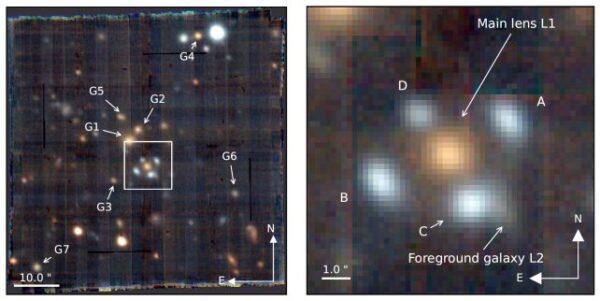
One of the rarest astronomical phenomena, one that exemplifies the gravitational lensing effect predicted by Albert Einstein’s theory of general relativity, has been discovered.
The find will have ramifications for years to come. One university said that it “only showcases the remarkable capabilities of modern astronomical instruments but also represents a significant step forward in our quest to understand the fundamental forces shaping our Universe.”
The discovery is “called an Einstein cross – when the curvature of space-time around a massive foreground object splits the light behind it into four, like the points of a cross. Its confirmation and analysis adds to a slowly growing catalog of these rare alignments, which can help us better understand the more distant reaches of the Universe.
A paper detailing the system has been accepted by The Astrophysical Journal Letters, and is available on preprint resource arXiv.
Space-time isn’t nice and flat. Gravity causes it to warp and wrinkle, which can have some interesting effects on any light traveling through it. Mostly, we observe these as something we call a gravitational lens.
Imagine, for example, a trampoline. If you place a heavy weight on the trampoline, the mat stretches and becomes curved. Anything then rolling across the mat follows the stretched and curved shape. Something similar happens to space-time: if a mass is significant enough, space-time warps and curves around it.”
#Space: four spectacular #quasar images surround a #galaxy #lenshttps://t.co/nkOEF3elax via @apod pic.twitter.com/KddBhBPDh0
— Maxime Duprez (@maximaxoo) July 18, 2021
Einstein’s Cross is an exceptional demonstration of how massive objects can bend and distort light as it travels through the fabric of spacetime. The Einstein Cross provides a unique opportunity for astronomers to study and gain insights into the properties of distant quasars and the nature of the gravitational lensing phenomenon. By analyzing the characteristics of each image, scientists can deduce valuable information about the lensing galaxy, such as its mass distribution and the geometry of the gravitational lensing effect.
The phenomenon is not only a captivating cosmic spectacle but also an essential tool for cosmologists and astrophysicists. It allows them to measure the Hubble constant, which represents the current rate of expansion of the universe. Since the lensing galaxy acts as a natural telescope, the time delays between the arrival of light from the quasar’s multiple images can be used to determine the Hubble constant accurately. Hence, the Einstein Cross plays a significant role in advancing our understanding of the universe’s expansion and the fundamental principles of general relativity. As technology and observation techniques continue to improve, it is likely that more fascinating gravitational lensing phenomena like the Einstein Cross will be discovered, providing astronomers with a wealth of new insights into the cosmos.










Physics Prophesy?? Wow